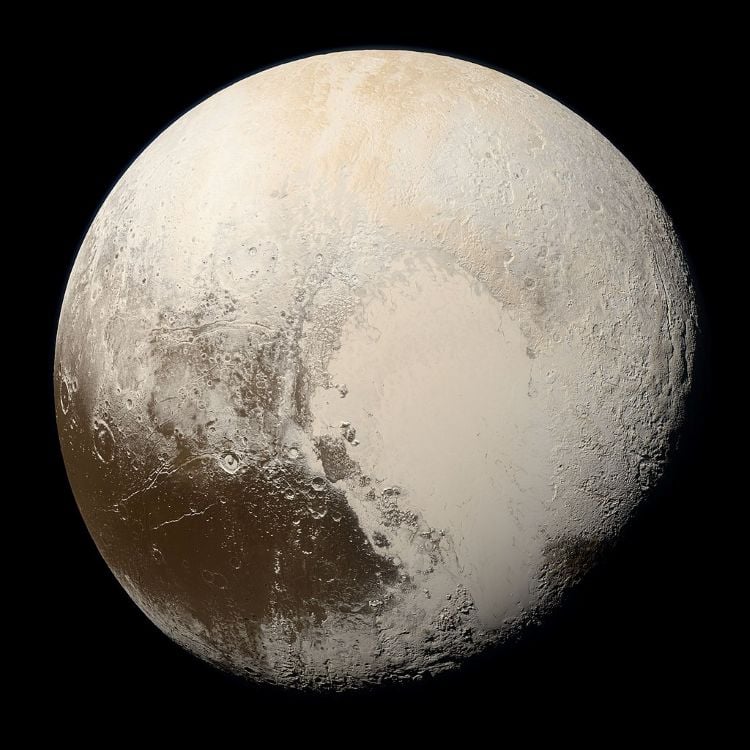Science
Researchers Uncover Evidence of Cryovolcanism on Pluto’s Hayabusa Terra

A recent study published in *The Planetary Science Journal* has revealed potential signs of cryovolcanism in Pluto’s Hayabusa Terra region. Researchers focused on the Kildaze caldera, examining its geological features to better understand the dwarf planet’s current geological activity. This investigation aims to shed light on how Pluto can exhibit such activity despite its significant distance from the Sun.
To conduct the study, the team utilized images captured by NASA’s New Horizons spacecraft during its historic flyby in July 2015. They compared these images with other known cryovolcanic sites on Pluto, such as Virgil Fossae and Viking Terra, as well as analog sites on Earth, including the Yellowstone and Valles Calderas. Additionally, they examined features on Mars, specifically collapsed pit craters located in Noctis Labyrinthus, a canyon-filled region of Valles Marineris, the largest canyon system in the solar system.
The researchers employed digital elevation models, elevation profiles, and three-dimensional visualizations to analyze the water ice present in Kildaze. Their findings suggest that the water ice is a few million years old, significantly younger than Pluto itself. The study concludes that Kildaze likely qualifies as a cryovolcano with a caldera structure, having experienced one or more eruptions that ejected approximately 1,000 km³ of cryolava, alongside potentially numerous smaller eruptions.
Cryovolcanism, which involves icy “magma” as opposed to molten rock, has been observed on various celestial bodies, including Ceres, Europa, and Enceladus. The study of cryovolcanism offers insights into the processes that drive geological activity across the solar system. Potential sources of cryovolcanism include external factors like crater impacts and tidal heating, as well as internal heat from radioactive decay.
What makes Pluto’s case particularly fascinating is its distance from the Sun, the farthest of any known planet. This raises questions about the mechanisms powering its geological activity. Scientists are divided on whether Pluto’s internal heating arises from tidal interactions with its largest moon, Charon, or from radiogenic heating due to radioactive decay within its core. A study published in March 2022 in *Icarus* posited that the internal heat generated by Charon’s influence may have allowed Pluto to retain warmth long after its formation billions of years ago.
Since the New Horizons mission, which remains the only spacecraft to have visited Pluto, several new missions have been proposed to further explore this distant world. These include plans for a fusion-powered orbiter-lander combination that could reach Pluto in just four years, a significant reduction compared to the nine years it took for New Horizons.
As researchers continue to analyze the data from New Horizons, they hope to unlock more secrets about Pluto’s geological activity and its implications for understanding cryovolcanism across the solar system. The future holds promising opportunities for scientific discovery, and the quest for knowledge about Pluto is far from over.
-

 Lifestyle5 months ago
Lifestyle5 months agoLibraries Challenge Rising E-Book Costs Amid Growing Demand
-

 Sports4 months ago
Sports4 months agoTyreek Hill Responds to Tua Tagovailoa’s Comments on Team Dynamics
-

 Sports4 months ago
Sports4 months agoLiverpool Secures Agreement to Sign Young Striker Will Wright
-

 Lifestyle4 months ago
Lifestyle4 months agoSave Your Split Tomatoes: Expert Tips for Gardeners
-

 Lifestyle4 months ago
Lifestyle4 months agoPrincess Beatrice’s Daughter Athena Joins Siblings at London Parade
-

 Science4 months ago
Science4 months agoSan Francisco Hosts Unique Contest to Identify “Performative Males”
-

 World4 months ago
World4 months agoWinter Storms Lash New South Wales with Snow, Flood Risks
-

 Science5 months ago
Science5 months agoTrump Administration Moves to Repeal Key Climate Regulation
-

 Business5 months ago
Business5 months agoSoFi Technologies Shares Slip 2% Following Insider Stock Sale
-

 Science5 months ago
Science5 months agoNew Tool Reveals Link Between Horse Coat Condition and Parasites
-

 Sports4 months ago
Sports4 months agoElon Musk Sculpture Travels From Utah to Yosemite National Park
-

 Science5 months ago
Science5 months agoNew Study Confirms Humans Transported Stonehenge Bluestones









